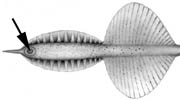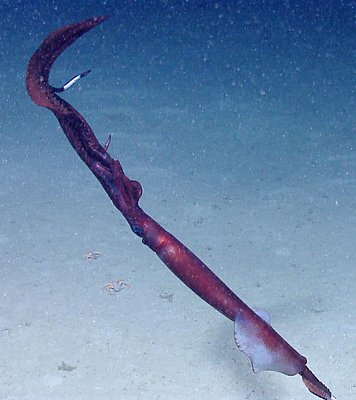Asperoteuthis
Richard E. Young and Clyde F. E. Roper- Asperoteuthis acanthoderma (Lu, 1977)
- Asperoteuthis mangoldae Young, Vecchione and Roper, 2007
- Asperoteuthis sp. B
- Asperoteuthis lui Salcedo-Vargas 1999
- Asperoteuthis nesisi Arkhipkin and Laptikhovsky 2008
Introduction
Little is known obout the biology of any species of Asperoteuthis. The most peculiar feature of this genus is the structure of the tentacular clubs. The distal half of the club has typical suckers and suggests that this part of the club functions in the usual capture of prey. The function of the bare proximal half of the club with its broad protective membranes is less clear but relates to another problem: How can the long and extremely slender tentacles, which in A. acanthoderma can be 7-12 times the mantle length (Tsuchiya and Okutani, 1993), be deployed? Perhaps the wide protective membranes of the proximal region of the club, which are composed virtually entirely of muscular trabeculae, function as muscular fins that swim the club into position.
Diagnosis
A chiroteuthid ...
- with suckers only on distal portion of tentacle-club.
- with atypical tragus and antitragus in funnel locking-apparatus which define a slender Y-shape or a slender curved groove.
- without photophores on arms IV.
Characteristics
- Arms
- Long, subequal in length in large subadults.
- Long, subequal in length in large subadults.
- Tentacles
- Club divided into two portions by symmetrical protective membranes.
- Suckers only on distal portion of club.
- Head
- Olfactory organ located well posterior to each eye.
- Olfactory organ located well posterior to each eye.
- Funnel
- Funnel valve present.
- Funnel-locking apparatus variable; with inverted Y-shaped groove that poorly defines a weak tragus and strong antitragus or a curved groove without an antitragus. Funnel-locking apparatus unknown in A. lui.
- Tail
- Long tail with “secondary fin” retained in adults.
- Long tail with “secondary fin” retained in adults.
- Photophores
- Photophores absent from viscera and arms IV.
- Large oval photophore patch on ventral surface of each eyeball.
- Luminescent pads on tentacles (also in Chiroteuthis).
- Aboral surface of club with large photophore on tip (see arrow) and two series of small photophores.
 Click on an image to view larger version & data in a new window
Click on an image to view larger version & data in a new window


Figures. Left - Ventral view of eye of Asperoteuthis acanthoderma from Tsuchiya and Okutani, 1993, showing photophore, with permission. Middle - Tentacle stalk photophores, same species. Drawing by J. R. Schroeder. Right - aboral view of club-tip photophore (arrow), Asperoteuthis mangoldae. Drawing by A. D. Hart.
Comments
These squid generally lose the tentacles during capture and can easily be confused with Grimalditeuthis. However the lack of a fused funnel-mantle locking apparatus easily distinguishes them.
| No. club suckers | Skin tubercules | Mantle with circular depressions | Arm sucker dentition | Arm II sucker size | Fin width | Size of club suckers | Aboral, small club photophores | Terminal club photophore | |
| A. acanthoderma | ~ 50 | Yes | No | 3-4 rounded teeth | Enlarged in mid-arm | 35-40% of ML | Equal | Lateral margins | Large |
| A. mangoldae | ~ 50 | No | No | 6-10 truncated teeth | No enlarged suckers | 45-65% of ML | Equal | Lateral margins | Small |
| Asperoteuthis sp. B | ND | ND | No | ND | No enlarged suckers | 50-55% of ML | ND | ND | ND |
| A. lui | 180 | ND | ND | ND | Enlarged in mid-arm | ND | Marginals larger | midline | Absent |
| A. nesisi | ND | Yes | Yes | 12-14 pointed teeth | Largest suckers mid-arm but not enlarged | 68% of ML | ND | ND | ND |
Nomenclature
Lu (1977) described Chiroteuthis acanthoderma. Nesis (1980) incorrectly synonymized this species with the incompletely described Chiroteuthis famelica Berry, 1909 (now = Mastigoteuthis famelica, see Young, 1991) and erected for it the new genus Asperoteuthis. The type species of the genus is C. acanthoderma Lu, 1977.
Discussion of Phylogenetic Relationships
Nothing is known of the phylogenetic relationships among the species.
Life History
Paralarvae are known for one species of Asperoteuthis (see Asperoteuthis mangoldae).
References
Lu, C. C. 1977. A new species of squid Chiroteuthis acanthoderma, from the Southwest Pacific (Cephalopoda, Chiroteuthidae). Steenstrupia, 4: 179-188.
Nesis, K. N. 1980. Taxonomic position of Chiroteuthis famelica Berry. Bull. Moscow Obshch. Ispyt. Prirody, sect. Biology, 85: 59-66. [In Russian].
Tsuchiya, K. and T. Okutani. 1993. Rare and interesting squids in Japan -X. Recent occurences of big squids from Okinawa. Venus, 52: 299-311.
Young, R. E. 1978. Vertical distribution and photosensitive vesicles of pelagic cephalopods from Hawaiian waters. Fishery Bulletin, 76: 583-615.
Young, R. E. 1991. Chiroteuthid and related paralarvae from Hawaiian waters. Bull. Mar. Sci., 49: 162-185.
Title Illustrations

| Scientific Name | Asperoteuthis acanthoderma (probable ID) |
|---|---|
| Location | Sigsbee Escarpment, Gulf of Mexico at 27?08'N, 90?29'W |
| Comments | ROV photograph of A. acanthoderma (?) swimming near the ocean floor at 1034 m in the Gulf of Mexico. Note the white area (absence of pigment) on a portion of the club and the ribbed secondary fin. Both features are characteristic of A. acanthoderma. |
| Identified By | Michael Vecchione |
| Copyright | © NOAA |
About This Page

University of Hawaii, Honolulu, HI, USA

Smithsonian Institution, Washington, D. C., USA
Page copyright © 2015 and
 Page: Tree of Life
Asperoteuthis .
Authored by
Richard E. Young and Clyde F. E. Roper.
The TEXT of this page is licensed under the
Creative Commons Attribution-NonCommercial License - Version 3.0. Note that images and other media
featured on this page are each governed by their own license, and they may or may not be available
for reuse. Click on an image or a media link to access the media data window, which provides the
relevant licensing information. For the general terms and conditions of ToL material reuse and
redistribution, please see the Tree of Life Copyright
Policies.
Page: Tree of Life
Asperoteuthis .
Authored by
Richard E. Young and Clyde F. E. Roper.
The TEXT of this page is licensed under the
Creative Commons Attribution-NonCommercial License - Version 3.0. Note that images and other media
featured on this page are each governed by their own license, and they may or may not be available
for reuse. Click on an image or a media link to access the media data window, which provides the
relevant licensing information. For the general terms and conditions of ToL material reuse and
redistribution, please see the Tree of Life Copyright
Policies.
- Content changed 22 November 2011
Citing this page:
Young, Richard E. and Clyde F. E. Roper. 2015. Asperoteuthis . Version 11 October 2015. http://tolweb.org/Asperoteuthis/19461/2015.10.11 in The Tree of Life Web Project, http://tolweb.org/













 Go to quick links
Go to quick search
Go to navigation for this section of the ToL site
Go to detailed links for the ToL site
Go to quick links
Go to quick search
Go to navigation for this section of the ToL site
Go to detailed links for the ToL site